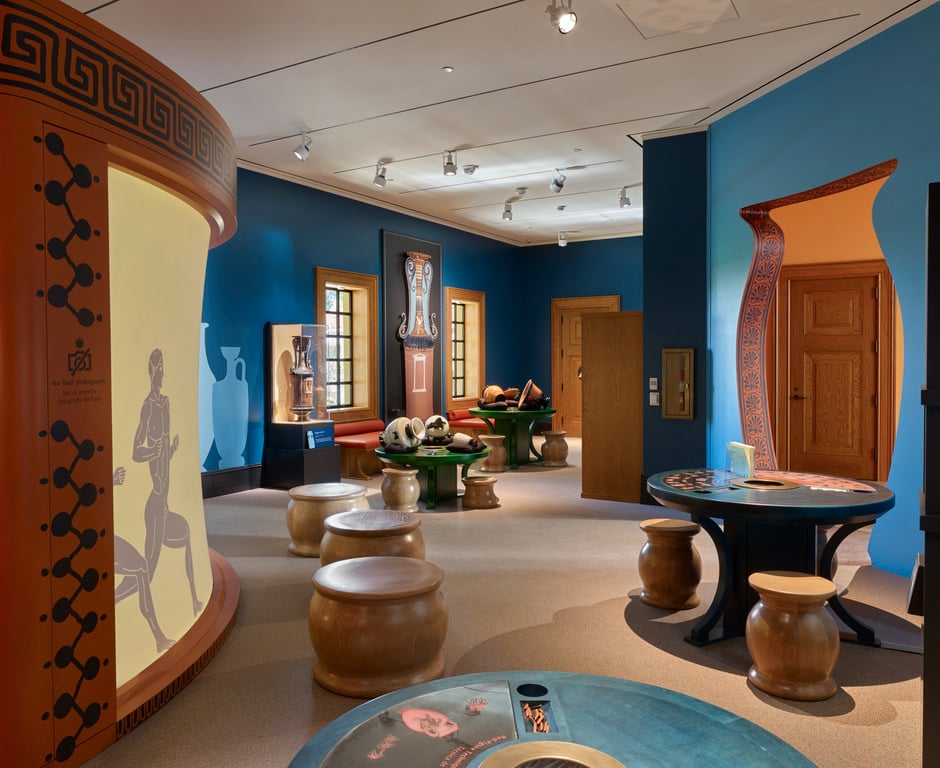
“Go to Pompeii and Herculaneum and see Roman villas the way they are now—then go to Malibu and see the way they were in ancient times.”
That’s what J. Paul Getty told the Los Angeles Times in 1974 when asked why he chose to model the Getty Villa’s design on an ancient Roman villa that was buried in the eruption of Mt. Vesuvius in 79 AD. (Nevermind that the villa was technically not built Malibu, but rather in its tony coastal neighbor to the south, Pacific Palisades.)
On April 18, the villa—a sister museum to the Getty Center that houses its Greek and Roman collection and first opened to the public in 1974—will reopen after a yearlong renovation and reinstallation that aims to more fully capture the history of ancient art. The new display reflects more than three years of work and research.
For most of its existence, the Getty Villa’s collection was arranged thematically. Works of art were sorted into categories based on their subject matter—athletes and competition, Gods and heroes, the Trojan War—regardless of the period, artistic movement, or geographic area from which they came.
The newly renovated Getty Villa. Courtesy of the Getty.
Timothy Potts, the director of the Getty Center and an antiquities expert, recognized the need for change—not necessarily to boost attendance, but to make the museum more art historically coherent. It was one of his first priorities upon joining the Getty in 2012.
“I felt the artistry became lost in it,” Potts told artnet News of the previous display. “You could not experience visually the evolution of styles, iconography, and subject matter that occurred over time.”
The new installation, overseen by Potts himself, is arranged chronologically. Visitors will begin in galleries devoted to the Neolithic and Bronze Ages of Greek art, then move on to Archaic, Classical, and Hellenistic periods, and end with ancient Roman sculpture. The display will dust off rarely seen work, like first-century AD frescoes from a city near Pompeii.
“Our understanding of how and why those changes take place is the backbone of art history,” Potts explained. “It’s the way we show the whole rest of the Getty’s collection at the Getty Center, from the medieval period through to the brink of the 20th century and even up to today in the photographs collection. Why wouldn’t we do the same for the ancient collection, which is equally important in terms of artistic quality?”
Getty Director Timothy Potts. Courtesy of the Getty.
The new-look villa also presents an expanded geographic scope. A new gallery will show material from neighboring ancient cultures, like Egypt and Persia, for the first time. And one of the inaugural exhibitions, “Palmyra: Loss and Remembrance,” brings together some of the finest examples of funerary portraiture from the ancient city of Palmyra outside of Syria. The show aims to illustrate how the ancient trading center produced art that fused Persian and Roman styles.
In addition to the reinstallation, the two-story museum also underwent small renovations, from the addition of new lighting to fresh layers of paint. There’s also 3,000 square feet more exhibition space spread across 33 galleries. (The villa remained open during the reinstallation process, though various galleries were closed for work intermittently.)
The newly renovated Getty Villa. Courtesy of the Getty.
Potts says he felt no pressure to make the museum flashier or more palatable to an Instagram-obsessed audience. But one of the Getty Villa’s inaugural shows may do the trick anyway. “Plato in LA: Contemporary Artists’ Visions,” a rare opportunity to see new art inside the villa, brings together work by artists who have been inspired by the Greek philosopher, including Mike Kelley, Michelangelo Pistoletto, and Paul McCarthy.
The most tenuously connected—but also most anticipated—work in the show is Jeff Koons’s monumental “Play Doh” sculpture, which curators have cheekily described as the platonic ideal of the chalky substance.
Jeff Koons, Play-Doh (1994–2014). © Jeff Koons.
Even without the inevitable boost from Koons, however, the villa does surprisingly well for itself in terms of attendance. It accounts for a healthy 25 percent of the Getty’s annual visitor numbers, which totals around two million. The director expects this number to stay roughly the same, if not grow a little, after the gallery reopens in full to the public. Admission, as always, will remain free.